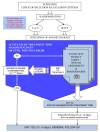Treatment of subcutaneous abdominal wound healing impairment after surgery without fascial dehiscence by vacuum assisted closure™ (SAWHI-V.A.C.®-study) versus standard conventional wound therapy: study protocol for a randomized controlled trial
- PMID: 24252551
- PMCID: PMC4225503
- DOI: 10.1186/1745-6215-14-394
Treatment of subcutaneous abdominal wound healing impairment after surgery without fascial dehiscence by vacuum assisted closure™ (SAWHI-V.A.C.®-study) versus standard conventional wound therapy: study protocol for a randomized controlled trial
Abstract
Background: A decision of the Federal Joint Committee Germany in 2008 stated that negative pressure wound therapy is not accepted as a standard therapy for full reimbursement by the health insurance companies in Germany. This decision is based on the final report of the Institute for Quality and Efficiency in Health Care in 2006, which demonstrated through systematic reviews and meta-analysis of previous study projects, that an insufficient state of evidence regarding the use of negative pressure wound therapy for the treatment of acute and chronic wounds exists. Further studies were therefore indicated.
Methods/design: The study is designed as a multinational, multicenter, prospective randomized controlled, adaptive design, clinical superiority trial, with blinded photographic analysis of the primary endpoint. Efficacy and effectiveness of negative pressure wound therapy for wounds in both medical sectors (in- and outpatient care) will be evaluated. The trial compares the treatment outcome of the application of a technical medical device which is based on the principle of negative pressure wound therapy (intervention group) and standard conventional wound therapy (control group) in the treatment of subcutaneous abdominal wounds after surgery. The aim of the SAWHI-VAC® study is to compare the clinical, safety and economic results of both treatment arms.
Discussion: The study project is designed and conducted with the aim of providing solid evidence regarding the efficacy of negative pressure wound therapy. Study results will be provided until the end of 2014 to contribute to the final decision of the Federal Joint Committee Germany regarding the general admission of negative pressure wound therapy as a standard of performance within both medical sectors.
Trial registration: Clinical Trials.gov NCT01528033German Clinical Trials Register DRKS00000648.
Figures


References
-
- Pessaux P, Msika S, Atalla D, Hay JM, Flamant Y. Risk factors for postoperative infectious complications in noncolorectal abdominal surgery: a multivariate analysis based on a prospective multicenter study of 4,718 patients. Arch Surg. 2003;138:314–324. doi: 10.1001/archsurg.138.3.314. - DOI - PubMed
Publication types
MeSH terms
Associated data
LinkOut - more resources
Full Text Sources
Other Literature Sources
Medical

